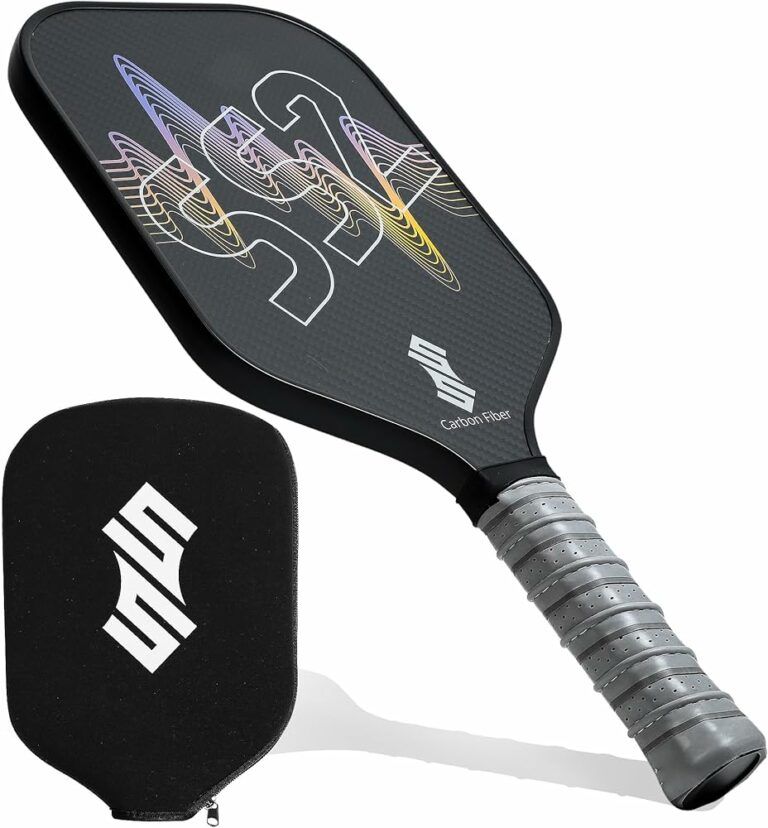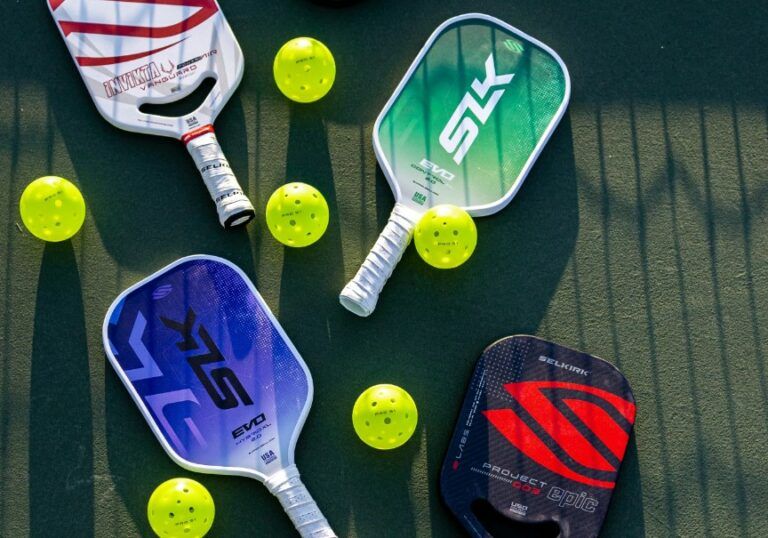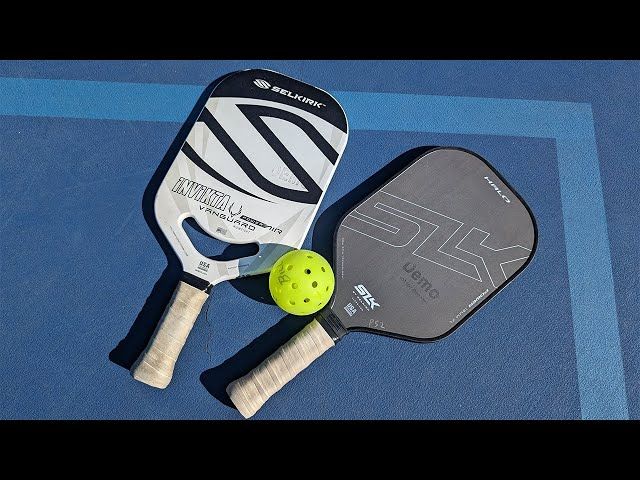Understanding Pickleball Paddle Weights
Choosing the correct weight classification of your pickleball equipment can significantly influence your overall playing experience. Understanding the different weight classifications is vital for optimizing your performance.
Lightweight paddles generally weigh less than 7.5 ounces. They are often constructed from materials like aluminum and advanced composites. These paddles are designed for players seeking agility and precise control. On the other hand, midweight paddles range between 7.5 and 8.4 ounces. Made from robust materials such as fiberglass, polymer, and composite cores, midweight paddles strike a balance between stability and power.
The weight classification not only affects the maneuverability but also the power generated during swings. Lighter paddles offer remarkable speed and quick responses, making them suitable for players who need rapid adjustments. Midweight paddles, conversely, provide enhanced power and stability, ideal for those who emphasize strong strokes and strategic play.
For players new to the game, understanding these distinctions is critical, as it lays the foundation for selecting a paddle aligned with their playing style and physical attributes.

Defining Lightweight Paddles
The appeal of lightweight paddles lies in their unique characteristics, allowing players to dominate the court with finesse and agility.
Maneuverability and Speed
Lightweight paddles weigh generally under 7.5 ounces, making them the go-to choice for players who prioritize quick reactions and rapid movements. Their significant benefit includes enhanced maneuverability, which is paramount during intense rallies where swift responses are vital. This agility allows you to control the ball exceptionally well and make precise adjustments in your gameplay.
Additionally, due to their lower weight, players experience dramatically reduced strain on the arm and wrist. This attribute is especially crucial during prolonged play sessions, as players can engage in extended matches without succumbing to fatigue or discomfort.

Control and Performance
The enhanced control offered by lightweight paddles aligns perfectly with players who rely on finesse and tactical exchanges. They allow for exceptional touch, facilitating optimal shot placement. Consequently, players who favor strategic gameplay and quick adjustments find these paddles advantageous.
Moreover, the materials used in lightweight paddles are engineered to maximize performance while minimizing strain, giving players confidence in their capabilities. However, it’s vital to recognize that while these paddles excel in control, they may present some challenges in generating substantial power behind shots.
Defining Midweight Paddles
Midweight paddles embody a robust alternative to their lighter counterparts, weighing between 7.5 to 8.4 ounces. They cater to a different set of player preferences, capitalizing on stability and power.
Power and Stability
One of the primary advantages of midweight paddles is their ability to generate more power than lightweight options. This characteristic is vital for aggressive players who thrive on impactful strokes and hard-hitting shots. Midweight paddles allow for greater power generation with less physical effort, a benefit for those who prefer to dominate from the baseline or execute strong drives.
Alongside power, midweight paddles provide a sense of stability during gameplay. This balance is essential for maintaining control during intense rallies and ensuring that shots are executed smoothly. Furthermore, these paddles typically minimize vibration upon impact, reducing the risk of injury, particularly for players with existing wrist or elbow issues.
Versatility Across Play Styles
Midweight paddles offer versatility that many players find beneficial. Their balanced design appeals to both aggressive and tactical players, allowing them to execute different strategies seamlessly. This adaptability makes it easier for advanced players to develop diverse skill sets while exploring various styles of play, a key contributor to consistent performance.
Performance Characteristics: Lightweight vs Midweight Pickleball Paddle
When considering paddle performance, multiple factors such as speed, control, and power come into play. Understanding how these factors manifest both in lightweight and midweight paddles assists players in making informed decisions.

Speed and Maneuverability of Lightweight Paddles
The rapid pace at which pickleball is played makes agility a fundamental trait for effective gameplay. Lightweight paddles excel in this regard, enabling swift reactions and enhanced control, particularly at the net. The reduced weight facilitates seamless fluidity in movements, providing an innate advantage for players who thrive on quick exchanges.
Power and Stability of Midweight Paddles
Conversely, midweight paddles shine in power generation and stability. Players using these paddles can deliver strong shots with controlled stability. Their design aids in absorbing impacts better than lightweight options, which benefits players seeking an aggressive style of play. The balance they provide enhances the overall gameplay experience, ensuring that players have the adaptability to execute different strategic techniques effectively.
Player Preferences and Ideal Profiles
The choice between lightweight vs midweight pickleball paddles often depends on personal gameplay styles and physical attributes.
Ideal Players for Lightweight Paddles
Agility, finesse, and quick reflexes define players who generally favor lightweight paddles. These paddles cater to beginners, senior players, and those who enjoy finesse-driven play styles. Their ability to minimize fatigue allows recreational players to enjoy prolonged sessions without undue strain.
Ideal Players for Midweight Paddles
In contrast, midweight paddles are best suited for individuals with more strength and balance who thrive on control and aggressiveness. Competitive teenagers and adults often prefer these paddles due to their robust feel and durability. Midweight paddles appeal to strategic players who value versatility and consistency in their gameplay.
Advantages and Disadvantages of Each Paddle Weight
Every paddle weight category comes with its own set of pros and cons. Understanding these can significantly aid in making the right selection.

Pros of Using Lightweight Paddles
- Agility: Enhanced speed and quick reaction times, providing edge in fast-paced matches.
- Control: Superior touch and precision allow for excellent shot placement.
- Reduced Fatigue: Minimal strain on the body, particularly beneficial for longer sessions.
- Comfort: Ideal for players preferring a lightweight feel during play.
Cons of Using Lightweight Paddles
- Power Limitations: May struggle to generate sufficient force for stronger shots.
- Smaller Sweet Spot: Tends to have a reduced sweet spot compared to heavier options.
- Durability Concerns: Potentially less durable under rigorous use.
- Feel and Balance: Might lack the solid feel some players prefer from heavier paddles.
Pros of Using Midweight Paddles
- Balanced Power: Enhanced power generation for aggressive plays.
- Stability: Provides controlled stability upon impact, reducing vibrations.
- Versatility: Suitable for various playing styles, enhancing overall gameplay.
- Durability: Generally more robust and long-lasting than lightweight counterparts.
Cons of Using Midweight Paddles
- Less Maneuverability: Slightly more challenging to maneuver compared to lightweight options.
- Potential for Fatigue: Higher weights might cause fatigue over extended periods.
- Adjustment Period: Players might require some time to adapt to the increased weight.
- Compatibility: May not fit every player’s style or physical attributes.
Health and Injury Considerations
Health considerations regarding paddle weight can significantly impact your gameplay experience.
Effects on Fatigue with Lightweight Paddles
The reduced strain associated with lightweight paddles enhances agility and promotes overall comfort, limiting overexertion during play. This characteristic is especially vital for players who may struggle with fatigue during longer matches.
Injury Prevention with Midweight Paddles
Midweight paddles promote shock absorption through stable performance, making them a preferred choice for individuals with existing injuries or physical concerns. Players can manage fatigue effectively by utilizing proper techniques aligned with their paddle choices.
Recommendations for Players with Existing Injuries
For individuals already facing physical challenges, it is essential to consult with healthcare professionals when selecting a paddle weight. Gradually transitioning to a new paddle and understanding the material characteristics can further assist in minimizing stress on the body.
Cost and Value Analysis
Understanding the financial aspect of paddle purchasing is crucial in ensuring you get the best value for your investment.

Price Range for Lightweight Paddles
Lightweight paddles can vary significantly in price depending on brand and material quality. Basic lightweight options might start as low as $30, while mid-range choices can go up to $80, featuring advanced technology and higher durability.
Price Range for Midweight Paddles
Midweight paddles generally range between $50 and $150, depending on the materials and construction quality. Premium options may offer additional features and longevity, making them a favorable investment for serious players.
Value for Money: Lightweight vs. Midweight
When evaluating the value of lightweight and midweight paddles, players should consider performance, cost, durability, and personal preferences. Understanding how these factors align with individual gameplay ensures an informed purchase decision.
Testing and Choosing the Right Paddle
Finding the right paddle weight involves thorough testing and consideration of personal preferences.
Recommended Methods for Testing Paddle Weight
One effective approach is engaging in demo programs provided by local clubs or attending tournaments where players can try multiple paddles. Participating in practice sessions allows players to explore different options while receiving recommendations from experienced individuals.
Determining Personal Paddle Preferences
Recognizing individual gameplay styles, physical condition, grip size, and material sensitivity plays a vital role in identifying the ideal paddle. This process involves trial and error, facilitating an understanding of what feels most comfortable during play.
Seeking Expert Advice
Consulting coaches, experienced players, and paddle specialists can immensely aid in making informed decisions. Online communities and product reviews also provide valuable insights, ensuring players choose a paddle that complements their style.
Customization and Accessories
Players may want to explore customizing their paddles to suit specific preferences better.
Adjusting Weight and Balance
Adding weight strips or changing grips can help players find the perfect balance and feel for their paddle. This customization caters to individual gameplay strategies and helps fine-tune equipment to enhance performance.
Combining Products for Flexibility
Players can also purchase additional grips to adjust the overall weight of their paddle, leading to a tailored experience that matches their unique playing style.
Addressing Misconceptions
Several misconceptions exist concerning paddle weights.
Common Myths About Lightweight Paddles
One prevalent myth is that lightweight paddles are only appropriate for beginners. In reality, many advanced players cherish lightweight paddles for their finesse and control.
Common Myths About Midweight Paddles
Another misconception is that midweight paddles can cause arm fatigue. This belief stems from misunderstandings about individual strength levels and how each paddle suits specific playing styles.
Real-World Examples and Reviews
Insights and experiences from professional players can illuminate the benefits and preferences concerning paddle choices.
Pro Player Insights
Numerous professional players have shared insights regarding their paddle preferences, favoring lightweight or midweight options based on their unique styles, reinforcing that successful athletes often choose what feels right for their gameplay.
Case Studies
Analyzing stories from different players also emphasizes the importance of selecting the proper weight based on personal preferences, strategies, and skill levels.
Conclusion
In summary, the choice between lightweight and midweight pickleball paddles hinges on various factors, including player style, physical attributes, and comfort preferences. Understanding the distinct characteristics of each paddle type is essential for optimizing performance and elevating your gameplay experience. Whether you lean towards the nimbleness of a lightweight paddle or the power of a midweight one, the ultimate goal is to select equipment that aligns with your individual gameplay, enhancing both enjoyment and success on the court.










